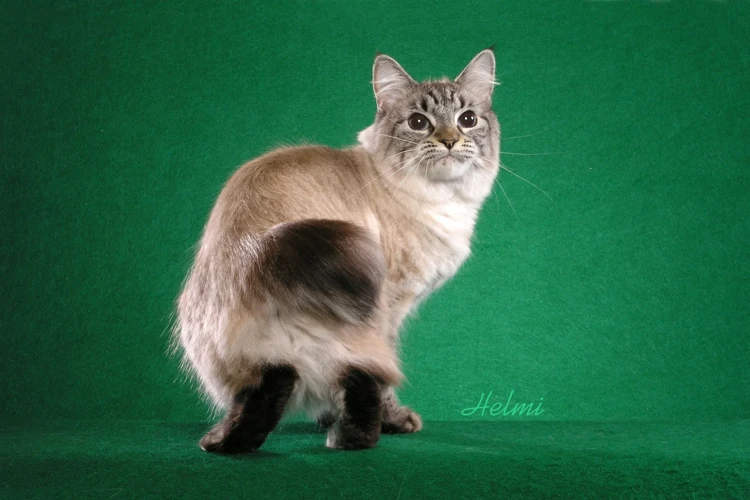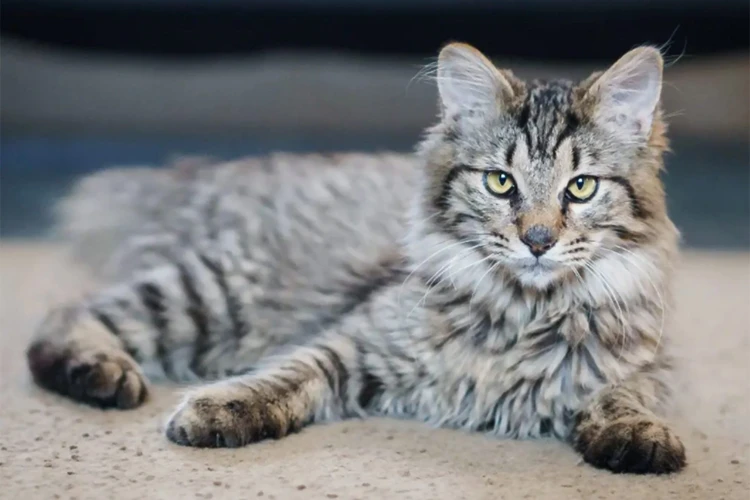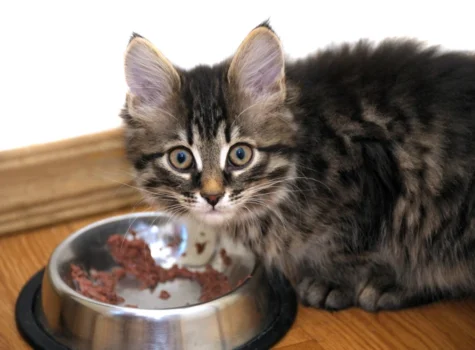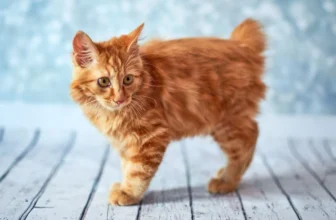Have you noticed your American Bobtail cat is experiencing persistent digestive issues, skin irritation or even hair loss? If so, your feline friend may be suffering from a food allergy. One highly effective way to determine the root cause of your cat’s allergies is by conducting an elimination diet. This process can help you identify which specific food(s) are causing your cat’s allergic reaction. However, before you start an elimination diet, it’s important to understand what it is, why it’s helpful, and how to conduct one step-by-step. In this article, we’ll delve into the details of conducting an elimination diet for American Bobtail cats, including what to avoid and which foods to reintroduce slowly.
What is an Elimination Diet?

Elimination diet is a method that helps to determine which foods are causing negative reactions in your cat. Food allergies can present themselves in many ways, such as digestive problems, skin rashes, and even behavioral changes. An elimination diet is a powerful tool that can help identify problem foods and improve your cat’s overall health. In this section, we will cover the basics of an elimination diet, including how it works and why it can be so helpful for American Bobtail cats. To learn more about food allergies in bobtail cats, check out our article “Food Allergies in American Bobtail Cats”.
What is a food allergy?
A food allergy is an adverse reaction of the immune system to a particular food. American Bobtail cats are prone to food allergies, making it essential to identify the allergen and eliminate it from your cat’s diet. Food allergies in American Bobtail cats can cause various symptoms, such as itching, vomiting, diarrhea, and gastrointestinal distress. Studies show that proteins are the most common allergens in cats, with chicken, beef, and fish topping the list.
What causes food allergies in American Bobtail cats?
Food allergies occur when the immune system mistakes a food protein as a foreign invader and produces an allergic reaction. The immune system triggers the production of antibodies and histamine, which can cause inflammation, itching, vomiting, and diarrhea. The symptoms of food allergy can be mild or severe and occur within a few minutes to hours after eating the allergenic food.
How is food allergy diagnosed?
Diagnosing food allergies in American Bobtail cats can be challenging, as the symptoms can be similar to other medical conditions. The veterinarian may recommend an elimination diet to identify the allergen. During the elimination diet, your cat will be fed a hypoallergenic diet that contains a novel protein source and carbohydrate source that your cat has never eaten before. If the symptoms improve during the elimination period, the veterinarian may recommend a food challenge to confirm the food allergy.
What are the treatment options for food allergies in American Bobtail cats?
The key to treating food allergies in American Bobtail cats is identifying and eliminating the allergenic food from the diet. The veterinarian may recommend a limited ingredient diet (LID) or a hypoallergenic diet that contains a novel protein source and carbohydrate source that your cat has never eaten before. The LID should be fed exclusively for at least 8-12 weeks to allow the immune system to calm down and the symptoms to subside.
Food allergies in American Bobtail cats can cause various symptoms, and it is essential to identify and eliminate the allergen from the diet. A hypoallergenic diet or a limited ingredient diet (LID) may be recommended by the veterinarian. To learn more about alternative protein sources for Bobtail allergies or the top hypoallergenic cat food brands for American Bobtail cats, check out our articles: Alternative Protein Sources for Bobtail Allergies or Top Hypoallergenic Cat Food Brands for American Bobtail Cats.
What is an elimination diet?
An elimination diet is a method of identifying and diagnosing food allergies and sensitivities in American Bobtail cats. This process involves removing potential allergens from your pet’s diet and slowly reintroducing them to pinpoint the problematic ingredient.
The elimination diet works in four stages:
- Stage 1: The first step of an elimination diet is to remove all foods that could be causing the allergy from your cat’s diet. This can include ingredients such as gluten, dairy, beef, chicken, and fish.
- Stage 2: After eliminating the potential allergens from your cat’s diet, it’s important to replace their regular food with a limited ingredient diet that only includes one source of protein and one source of carbohydrate. This carefully curated diet helps limit the number of ingredients your cat is exposed to and can help pinpoint the specific allergens your cat is reacting to.
- Stage 3: During this stage, you will closely monitor your cat for any signs of improvement. If the elimination diet is working, you should start to see an improvement in your pet’s symptoms within a month of starting the diet. Common signs to look for include reduced itching, ear infections, vomiting, and diarrhea.
- Stage 4: The final stage of the elimination diet is reintroducing various food items one at a time. This helps identify which foods are triggering an allergic reaction in your feline friend. Once you have pinpointed the allergen, you can remove it from your cat’s diet completely.
It’s important to note that the elimination diet is not a quick fix and requires dedication and patience from both you and your cat. The process can take several weeks and even months to complete. However, identifying and removing allergens from your cat’s diet can improve their quality of life and help prevent future health issues.
If you want to learn more about food allergies in American Bobtail Cats, you can read our article on Bobtail Cat Food Allergies.
Why is an elimination diet helpful for American Bobtail cats?
The Importance of Conducting an Elimination Diet for American Bobtail Cats
Conducting an elimination diet is essential if you suspect that your American Bobtail cat is having allergic reactions to their food. Food allergies are a common problem among cats, and they can lead to various health issues ranging from mild to severe. An elimination diet can help you identify the root cause of your cat’s food allergy and work towards finding a solution to the problem.
There are many reasons why an elimination diet is helpful for American Bobtail cats. Here are some of the most significant benefits:
| Benefits of Conducting an Elimination Diet |
|---|
| Identify Food Allergies |
| An elimination diet is an effective method for diagnosing food allergies in American Bobtail cats. By eliminating potential allergens from your cat’s diet and introducing them back one by one, you can determine which foods trigger an allergic reaction. |
| Improve Digestive Health |
| Food allergies can lead to digestive problems in American Bobtail cats, such as vomiting and diarrhea. By removing allergens from their diet, you can reduce the strain on their digestive system and improve their overall digestive health. |
| Reduce Skin Irritation |
| Food allergies can also cause skin irritation in American Bobtail cats. Symptoms include scratching, itching, and rashes. An elimination diet can help identify the allergens causing these skin issues and alleviate them by removing the problematic foods from your cat’s diet. |
| Improve Energy and Activity Levels |
| Food allergies can leave cats feeling lethargic and less active. By identifying and removing the allergens from their diet, you can restore your American Bobtail cat’s energy and activity levels to their optimal state. |
An elimination diet is a crucial step in ensuring that your American Bobtail cat maintains good health and wellbeing. By identifying and removing problematic foods from their diet, you can improve their digestive health, reduce skin irritation, and alleviate the symptoms of food allergies. It is essential to consult with your veterinarian before starting an elimination diet to ensure that you do it properly and safely.
How to Conduct an Elimination Diet

Embarking on an elimination diet for your American Bobtail cat can seem like a daunting task, but with the right guidance and resources, it can be manageable and even beneficial for your furry companion’s health. Here we will delve into the step-by-step process of conducting an elimination diet, including necessary precautions and tips for success. By following these guidelines, you can help identify and eliminate any potential allergens in your cat’s diet and improve their overall well-being.
Step 1: Consult Your Veterinarian
Step 1: Consult Your Veterinarian
Before starting an elimination diet for your American Bobtail cat, it is important to consult with your veterinarian. They will be able to provide specific advice based on your cat’s individual health and dietary needs. They can also help rule out any underlying medical conditions that may be causing your cat’s symptoms.
During your consultation be sure to discuss your cat’s symptoms such as itching, vomiting, or diarrhea, how long the symptoms have been going on, and if any recent changes have been made to your cat’s diet or environment. You should also inform your vet of any medications or supplements your cat is currently taking.
Your vet may suggest starting a food diary or using a hypoallergenic diet to help determine the cause of your cat’s symptoms. A food diary will allow you to track what your cat eats and any symptoms that occur afterward, while a hypoallergenic diet eliminates common allergens to determine if your cat’s symptoms improve.
Here is an example of a food diary to keep track of what your cat eats and any symptoms that occur:
| Date | Time | Meal/Food | Amount | Any Symptoms? |
|---|---|---|---|---|
| 10/1/2021 | 7:00am | Wet food – Chicken | 1/2 can | None |
| 10/1/2021 | 12:00pm | Dry food – Salmon | 1/4 cup | Vomiting (1 hour after) |
| 10/1/2021 | 5:00pm | Wet food – Turkey | 1/2 can | Itching (1 hour after) |
Speaking with your veterinary is an essential first step in conducting an elimination diet for your American Bobtail cat. They can provide informed advice and help you rule out any underlying medical conditions. Keeping a food diary can help you track what your cat eats and any symptoms that occur, which can be reviewed with your vet to determine the potential cause of your cat’s symptoms.
Step 2: Choose a Limited Ingredient Diet
When conducting an elimination diet for your American Bobtail cat, it’s crucial to choose a limited ingredient diet. This type of diet will help you identify any potential allergens by limiting the number of ingredients your cat is consuming. Here are some tips on how to choose a limited ingredient diet for your feline friend:
- Read Labels: Make sure to read the labels of each cat food container carefully. Check the ingredients list to ensure the food doesn’t contain any of the common allergens found in American Bobtail cats, such as poultry or grains.
- Protein Source: Choose a food that has a novel protein source that your cat has never eaten before. This could be venison, duck, or rabbit.
- Carbohydrate Source: Similarly, select a carbohydrate source that your cat hasn’t eaten before. Sweet potatoes or peas are good options.
- Grain-Free: Many American Bobtail cats are allergic to grains. It’s essential to choose a grain-free diet.
- Avoid Fillers: Avoid cat foods with fillers such as corn, wheat, and soy, which can cause allergic reactions.
By choosing a limited ingredient diet that eliminates common allergens and includes novel protein and carbohydrate sources, you can help ensure the success of your cat’s elimination diet. Remember that any treats or additional foods you give to your cat during this time must also be part of the limited ingredient diet to avoid any potential issues.
Step 3: Monitor Your Cat’s Progress
During the elimination diet, it is essential to closely monitor your American Bobtail cat’s progress to determine if the limited ingredient diet is working effectively or not. Here are a few important things to consider when monitoring your cat’s progress:
| Factors to Observe | What to Look For |
|---|---|
| Elimination habits | Observe your cat’s litter box habits. Is your cat stool forming normally? Is there a change in color or consistency? If you notice any changes or irregularities, it may be because of the new diet. |
| Energy Levels | Is your cat’s energy level consistent? Is your cat showing any signs of lethargy, weakness or unusual behavior? If so, it could be because the new diet is not providing the cat with the required nutrients. |
| Weight | Monitor your cat’s weight throughout the elimination diet. If your cat is losing more weight than expected or gaining weight, it may be a sign that you need to adjust the portions. Consult with your veterinarian if there are any significant changes in weight. |
| Skin and Coat Health | Check your cat’s skin and coat health. If your cat is scratching or showing signs of inflammation, it may be because the diet is not suitable for your cat or due to an allergy. A healthy diet leads to healthy skin and coat. |
It is crucial to document and take note of any changes or abnormalities observed during the elimination diet. Keeping track of any differences in behavior, well-being, and physical appearance will help you determine whether or not the diet is appropriate for your cat. If you notice any significant negative changes, cease the diet, immediately contact your veterinarian and take your cat to a veterinary specialist.
Step 4: Reintroduce Foods One at a Time
Once your American Bobtail cat has been on the limited ingredient diet for a specified period, your veterinarian may recommend reintroducing foods one at a time to see which foods trigger an allergic reaction. This process helps identify the problematic food and allows you to avoid feeding it to your cat in the future. Reintroducing foods should be done slowly and with caution to avoid any adverse reactions.
To reintroduce foods, start by selecting a single ingredient that was not included in the limited ingredient diet. Introduce it to your cat in small portions, mixed with the current diet. Observe your cat for a few days for any signs of an allergic reaction. If there are no reactions, gradually increase the amount of the food over the next few days. If there are any symptoms such as vomiting, diarrhea, or itching, stop giving your cat the food immediately and consult your veterinarian.
Keep a detailed record of every food reintroduced to your cat, including the brand name and flavor. This information is crucial when identifying the problematic food that caused the allergic reaction. Once you have reintroduced all potential allergens, and your cat has reacted to some foods, exclude those foods from their diet permanently.
It’s worth noting that in many cases, American Bobtail cats may have sensitivities to several foods. The reintroduction of foods should proceed slowly and with caution to avoid overwhelming your cat’s digestive system. A helpful tip is to use an HTML table to keep track of this information, as demonstrated below.
| Foods Reintroduced | Reaction (Yes/No) | Notes |
|---|---|---|
| Chicken – Brand A | No | N/A |
| Salmon – Brand B | Yes | Developed itching and diarrhea. Excluded from cat’s diet. |
| Lamb – Brand C | No | N/A |
| Duck – Brand D | No | N/A |
Reintroducing foods one at a time is an essential part of conducting an elimination diet for American Bobtail cats to identify food allergies accurately. Keeping a detailed record of each reintroduced food’s reaction is crucial for identifying problematic foods and avoiding them in the future. Remember to proceed slowly and with caution when reintroducing foods to avoid any adverse reactions.
Foods to Avoid During the Elimination Diet
Now that you know the steps to conducting an elimination diet for your American Bobtail cat, it’s important to know which foods you should avoid during this process. It can be tough to decipher what ingredients are causing your cat’s allergies, so a limited ingredient diet is key. Avoiding common allergens and other ingredients can help you pinpoint exactly what is causing the reaction. Let’s take a closer look at what foods to steer clear of during the elimination diet process.
Common Allergens in American Bobtail Cats
When conducting an elimination diet for American Bobtail cats, it’s important to be aware of the most common allergens that may cause a reaction in your furry friend. To help you identify what to avoid, we’ve compiled a list of the most common allergens in American Bobtail cats.
Common Allergens in American Bobtail Cats
| Allergen | Description |
|---|---|
| Chicken | This protein is commonly used in commercial cat foods and can cause allergic reactions in some American Bobtails. |
| Beef | While beef is a common ingredient in many commercial cat foods, it is a leading cause of food allergies in cats. |
| Fish | Fish is another common ingredient in commercial cat foods, but it can cause allergies in some American Bobtails. |
| Wheat | Wheat is a common ingredient in many commercial cat foods and can lead to digestive issues and allergic reactions in some cats. |
| Soy | Like wheat, soy is also commonly used in commercial cat foods and can cause allergic reactions in some American Bobtails. |
It’s important to note that these are just the most common allergens and your American Bobtail may have an allergic reaction to other ingredients. It’s important to closely monitor your cat throughout the elimination diet process to ensure that they’re not exhibiting any adverse reactions to the limited ingredient diet. If you suspect an allergy to a specific ingredient, consult with your veterinarian for advice on what to do next.
Other Ingredients to Avoid
During an elimination diet, it’s crucial to avoid not only common allergens but also other ingredients that may cause adverse reactions in American Bobtail cats. Some of these ingredients include:
| Ingredient | Description |
| Corn | Common filler ingredient in commercial cat food that can be difficult for cats to digest. |
| Wheat | Another common filler ingredient in commercial cat food that may cause digestive issues and skin problems in some cats. |
| Soy | May cause digestive issues and allergic reactions in some cats. |
| Dairy | Cats are lactose intolerant, which means dairy products can cause diarrhea and other digestive issues. |
| Artificial flavors and colors | May cause allergic reactions and behavioral problems in some cats. |
| Preservatives | Some preservatives, such as sulfites and BHA/BHT, may cause allergic reactions in cats. |
It’s important to carefully read the ingredient labels of any commercial cat food and avoid any products that contain these ingredients during the elimination diet. Stick to simple, limited ingredient diets during this time to effectively identify any potential food allergens.
Conclusion
In conclusion, conducting an elimination diet for American Bobtail cats can be an effective way to identify and eliminate potential food allergens from their diet. By following the step-by-step process outlined, cat owners can work with their veterinarians to ensure their cat’s health and well-being. It’s important to remember that each cat is unique and may have different sensitivities and allergies. Thus, it’s advised to be patient and dedicated throughout the process. It may take several weeks or even months to identify the specific allergens affecting a cat’s health, but the results can be life-changing. Moreover, choosing a limited ingredient diet and monitoring your cat’s progress closely can prevent future health problems and provide a better quality of life for your beloved American Bobtail cat. Remember to avoid common allergens such as chicken, fish, and grains. Finally, always consult with a veterinarian before making any changes to your cat’s diet.
Frequently Asked Questions
How common are food allergies in American Bobtail cats?
Food allergies are relatively uncommon in American Bobtail cats compared to other breeds, but they can still develop allergies to certain ingredients in their diet.
What are the symptoms of a food allergy in American Bobtail cats?
Symptoms of a food allergy can include excessive scratching and grooming, hair loss, ear infections, vomiting, diarrhea, and general skin irritation.
What is the difference between a food allergy and intolerance?
A food allergy is an immune response to a specific ingredient in a cat’s diet, while a food intolerance occurs when a cat has difficulty digesting a certain food but doesn’t involve an immune response.
How long should an elimination diet last?
An elimination diet should last between 8-12 weeks to properly identify any potential food allergies in your American Bobtail cat.
What kind of limited ingredient diets are available for American Bobtail cats?
There are many limited ingredient diets available for American Bobtail cats, ranging from freeze-dried raw diets to canned and kibble options. Your veterinarian can recommend one that is best suited for your cat’s individual needs.
Can I give my American Bobtail cat treats during an elimination diet?
It is best to avoid giving your American Bobtail cat any treats or human food during an elimination diet, as it could interfere with the results.
What if my American Bobtail cat doesn’t show any improvement during the elimination diet?
If your American Bobtail cat doesn’t show any improvement during the elimination diet, it is important to consult with your veterinarian to rule out any other possible health issues.
How can I tell if my American Bobtail cat is allergic to more than one ingredient?
If your American Bobtail cat is allergic to more than one ingredient, they may show symptoms even after completing the elimination diet. In this case, your veterinarian may recommend an intradermal skin test or blood test to identify the specific allergens.
What should I do if my American Bobtail cat eats a food they are allergic to during the elimination diet?
If your American Bobtail cat accidentally eats a food they are allergic to during the elimination diet, it is important to restart the process from the beginning to properly identify any potential food allergies.
Can an elimination diet benefit cats who don’t have food allergies?
An elimination diet is not recommended for cats who don’t have food allergies, as it can be a lengthy and restrictive process without any clear benefits.







